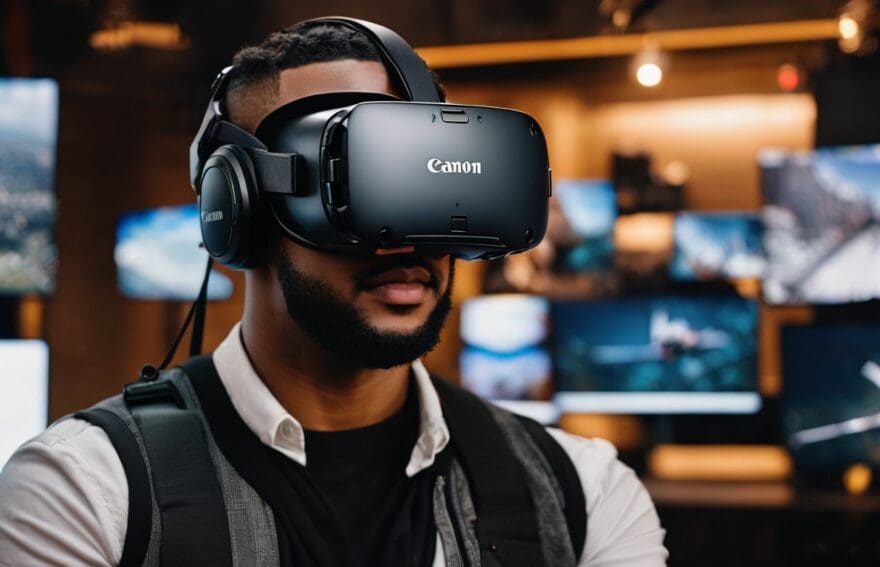Virtual Reality Esports: A New Frontier for Competitive Gaming

Updated On: November 29, 2025 by 
Are you tired of traditional gaming experiences and looking for something more immersive? As passionate gamers ourselves, we understand the need for a new frontier in competitive gaming. Did you know that virtual reality esports is revolutionizing the way we play games? In this article, we’ll explore the potential of VR in esports and how it’s shaping the future of competitive gaming. Join us as we dive into the world of virtual reality esports and discover an exciting new dimension to gaming.
The rise of esports and its global impact
Esports has transformed from a niche hobby to a global phenomenon, captivating millions across the world. We’ve witnessed the explosion of virtual competitions where professional gamers clash in digital arenas, pushing competitive gaming into the limelight.
From local tournaments to international championships, esports is now a major player in the entertainment industry, with streams attracting viewers more than ever before.
This rapid ascent has turned virtual battles into big business. Major brands sponsor teams and events while streaming platforms broadcast matches to eager fans around the globe. The industry’s growth isn’t slowing down; it’s redefining sports as we know it and cementing its position within mainstream culture.
Virtual reality esports promises to take this impact further, merging physical realities with digital worlds and creating immersive experiences that draw players and audiences alike into riveting new dimensions of gameplay.
Exploring Virtual Reality in Esports
Virtual reality esports, or VR esports, is the fusion of competitive gaming and immersive virtual reality technology. This emerging trend in the gaming industry offers a new level of player experience and audience engagement.
What is virtual reality esports?
Imagine stepping into an arena where the game surrounds you, and every move you make translates into action. That’s what virtual reality esports is all about – we strap on VR headsets, grip our controllers, and dive headfirst into immersive gaming experiences that are as intense as any physical sport.
As players, we embody our avatars in a digital realm, engaging in competitions that challenge both mind and body. It’s not just about quick reflexes; it requires spatial awareness, strategy, and teamwork.
We’re seeing a surge in virtual reality tournaments as this cutting-edge technology blurs the lines between the real world and fantastic digital landscapes. With the metaverse expanding rapidly, it’s offering us new playgrounds for competition.
Here we compete not only for glory but also for tangible rewards like virtual merchandise or even real estate within these alternate worlds. The buzz around esports has already made waves across industries – now add VR to the mix and we’re witnessing a seismic shift in how competitive gaming unfolds.
Now let’s delve into why integrating VR takes esports to unparalleled heights.
Advantages of incorporating VR in esports
Virtual reality (VR) in esports offers an immersive gaming experience, allowing players to feel like they are inside the game. With VR technology, gamers can interact with the virtual environment and compete in a more engaging way, enhancing their overall gaming experience.
The hands-free nature of VR eliminates the physical barriers of traditional gameplay, enabling greater freedom of movement and enhancing player mobility within the game.
Moreover, incorporating VR in esports opens up a new realm of possibilities for competitive gaming. It allows for innovative gameplay mechanics that go beyond traditional controller-based interactions, making games more interactive and captivating.
The Evolution of Gameplay
The Evolution of Gameplay explores how virtual reality enhances the gaming experience, engaging the senses in ways traditional gaming cannot. It offers a new level of immersion that brings gamers closer to the action than ever before.
How VR enhances the gaming experience
Virtual reality (VR) enhances the gaming experience by immersing players in a 3D environment, allowing them to interact with their surroundings and engage all their senses. With VR, gamers can physically move within the virtual space, providing a more realistic and engaging gameplay experience.
The technology also enables players to feel present in the game world, creating a sense of immersion that traditional gaming cannot match. Furthermore, VR provides an opportunity for gamers to experience heightened levels of excitement and adrenaline as they navigate through intense virtual environments.
Engaging the senses in virtual reality esports
Immersing oneself in virtual reality esports engages all the senses, from sight to sound and even touch. Through advanced audio-visual technology, gamers can feel like they are truly inside the game world, with 3D visuals and spatial sound enhancing their experience.
The tactile feedback of VR controllers further adds a layer of realism, allowing players to interact with objects and environments within the game. As a result, virtual reality esports provides an unmatched level of sensory immersion that traditional gaming simply cannot replicate.
With seamless integration into virtual environments, players can not only visually perceive but also physically sense the actions they perform within the game. This stimulation creates an unparalleled level of engagement that draws both passionate and novice gamers into a new dimension of competitive gaming.
Challenges and Opportunities
Navigating the technical and practical challenges of integrating virtual reality into esports can be daunting, but the potential growth and opportunities in VR esports are vast. From immersive gameplay experiences to expanding the reach of competitive gaming, there’s a lot to explore in this new frontier.
Navigating the technical and practical challenges
Addressing the technical and practical challenges in virtual reality esports requires innovative solutions to enhance the overall player experience. Integrating advanced AV technology is crucial for creating immersive environments that transport players into virtual worlds with seamless and realistic interactions.
Overcoming hardware limitations, such as latency and motion sickness, through continuous advancements plays a pivotal role in ensuring that VR esports remains accessible and enjoyable for all gamers.
As developers strive to meet these challenges, extensive research into player experiences, attitudes towards VR esports, and the impact of hands-free VR on competitive gaming is essential.
The potential growth and opportunities in VR esports
Virtual Reality Esports opens up new frontiers for competitive gaming, attracting a surge of enthusiasts and paving the way for innovative monetisation opportunities. The evolution of interactive gaming is driving the industry’s growth, fuelled by advancements in gaming technology and increasing popularity within the global gaming community.
As VR continues to bridge the physical and virtual worlds in esports, it presents exciting prospects for immersive gameplay experiences while also offering potential avenues for virtual merchandise and real estate sales within the game.
The metaverse is reshaping interactive gaming as we know it, blurring boundaries between reality and simulation, creating an environment where players can connect with others worldwide and participate in diverse tournaments.
The Convergence of Realities
Bridging the physical and virtual worlds in esports opens up a whole new realm of possibilities for competitive gaming. The impact of VR on traditional sports and media is undeniable, and it’s reshaping the way we interact with games and entertainment.
Bridging the physical and virtual worlds in esports
Virtual reality (VR) in esports is not just about immersing players in a digital world; it’s about blending the physical and virtual realities to create an unparalleled gaming experience.
VR technology is revolutionizing competitive gaming by seamlessly integrating players into the game environment, fostering heightened sensory engagement and physical interaction. This convergence has opened up new dimensions for both passionate and novice gamers, breaking down traditional barriers between the real and virtual worlds.
The integration of VR in esports transcends conventional gameplay, offering a transformative medium that beckons players to physically engage with the digital landscape. Virtual Reality Esports Metaverse enables participants to navigate through tournaments while experiencing genuine social interactions within a virtual realm, effectively merging physical sensations with digital exploration.
The impact of VR on traditional sports and media
Virtual reality (VR) has made a significant impact on traditional sports and media, creating immersive experiences for fans and participants alike. Through VR technology, audiences can now enjoy an elevated viewing experience, feeling as though they are right in the midst of the action.
Furthermore, traditional sports are being reimagined through VR simulations, allowing players to engage with their favourite physical activities in virtual realms. This convergence of real-world sports and virtual reality is reshaping the way we perceive and interact with sporting events.
In addition to its influence on traditional sports, VR has also revolutionised media consumption. With VR headsets, users are transported into interactive environments where they can engage with content in ways previously unimaginable.
The Future of VR Esports
With the advancements in technology and the growing popularity of virtual reality, VR esports is poised to become a significant player in the competitive gaming scene. As VR continues to evolve and improve, we can expect to see an increase in the number of games designed specifically for virtual reality gameplay, as well as more tournaments and events dedicated to VR esports.
Predictions and expectations for the growth of VR esports
We predict significant growth in VR esports as virtual reality technology becomes more accessible and affordable. The increasing popularity of VR headsets, coupled with the immersive experience they offer, is expected to attract a larger audience to VR esports tournaments and events.
As hardware and software continue to evolve, we anticipate a surge in the development of VR-specific games designed for competitive gaming within virtual environments. Additionally, advancements in motion tracking and haptic feedback technologies are likely to enhance players’ experience and further drive the growth of VR esports.
Furthermore, as industry stakeholders invest more resources into VR esports infrastructure and marketing initiatives, we expect an expansion in sponsorship deals and collaborations with major brands seeking to connect with this growing demographic of gamers.
How VR will shape the future of competitive gaming
As we anticipate the future of competitive gaming, it’s clear that Virtual Reality (VR) will play a pivotal role in shaping the landscape. The immersive nature of VR technology has already begun revolutionising the way gamers experience and engage with their favourite titles.
With advancements in hands-free VR and location-based VR esports games, players are being transported into hyper-realistic environments, blurring the lines between physical and virtual worlds.
As we move forward, VR is poised to create a new frontier for competitive gaming, offering unprecedented levels of immersion and interactivity that could redefine the entire esports industry.
Gamers can expect an evolution in gameplay experiences as VR enhances sensory engagement within virtual reality esports. This heightened level of immersion not only captivates players but also opens doors to monetisation opportunities through virtual merchandise sales within games like never before.
Conclusion
The future of competitive gaming is being reshaped by Virtual Reality Esports, offering new opportunities for players and spectators. This technological advancement has the potential to revolutionise how we experience and interact with video games.
As VR continues to grow in popularity, its impact on the esports industry is poised to be substantial. With ongoing developments and research, it’s clear that virtual reality will play a significant role in shaping the future of competitive gaming.
FAQs
1. What are Virtual Reality Esports?
Virtual Reality Esports, or VR Esports, is a new kind of competitive gaming where players go head-to-head in games using virtual reality technology.
2. How is VR changing the world of competitive gaming?
VR adds an immersive dimension to egaming tournaments, allowing players and viewers to experience games in a more realistic and engaging way.
3. Can anyone participate in Virtual Reality Esports?
Yes! Whether you’re an experienced gamer or just starting out, there’s room for all skill levels in the exciting world of VR competitive gaming.
4. Are Virtual Reality Esport events different from regular esports competitions?
Indeed they are; VR esports bring gamers into 3D environments that require physical movement and strategy, offering a unique twist on traditional seated eGaming contests.


